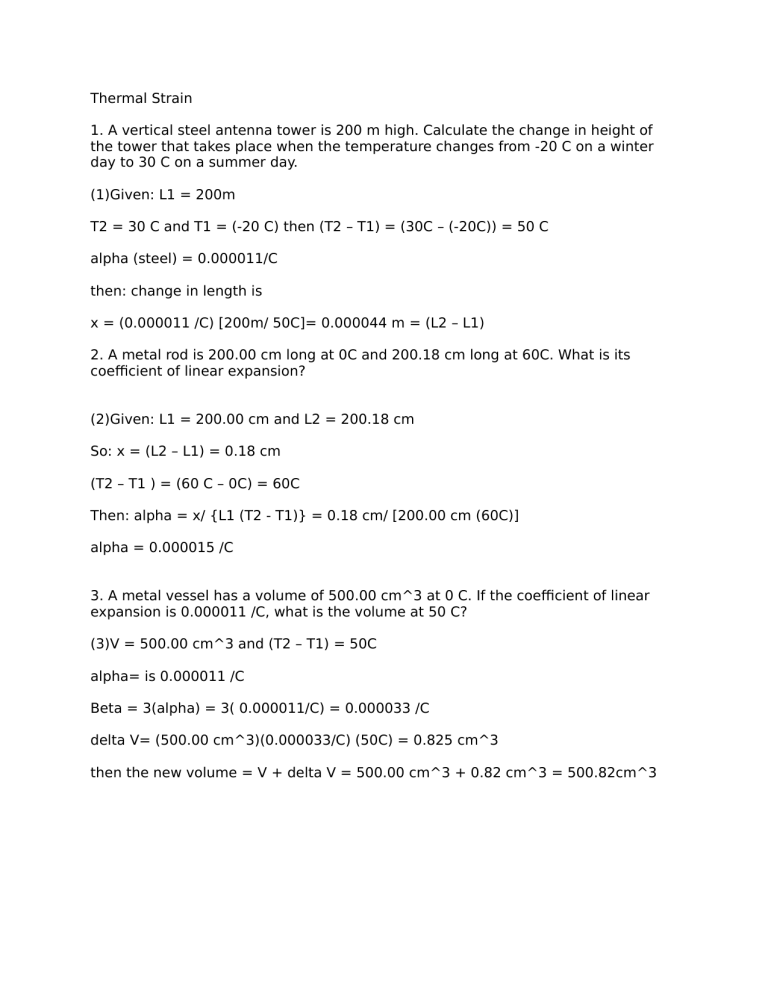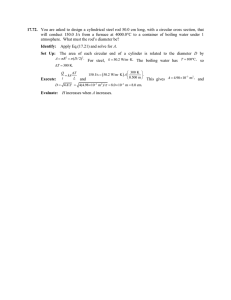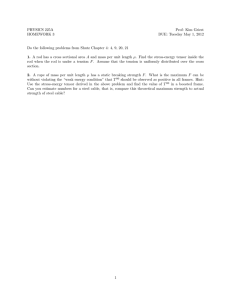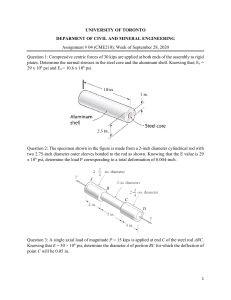
Thermal Strain
1. A vertical steel antenna tower is 200 m high. Calculate the change in height of
the tower that takes place when the temperature changes from -20 C on a winter
day to 30 C on a summer day.
(1)Given: L1 = 200m
T2 = 30 C and T1 = (-20 C) then (T2 – T1) = (30C – (-20C)) = 50 C
alpha (steel) = 0.000011/C
then: change in length is
x = (0.000011 /C) [200m/ 50C]= 0.000044 m = (L2 – L1)
2. A metal rod is 200.00 cm long at 0C and 200.18 cm long at 60C. What is its
coefficient of linear expansion?
(2)Given: L1 = 200.00 cm and L2 = 200.18 cm
So: x = (L2 – L1) = 0.18 cm
(T2 – T1 ) = (60 C – 0C) = 60C
Then: alpha = x/ {L1 (T2 - T1)} = 0.18 cm/ [200.00 cm (60C)]
alpha = 0.000015 /C
3. A metal vessel has a volume of 500.00 cm^3 at 0 C. If the coefficient of linear
expansion is 0.000011 /C, what is the volume at 50 C?
(3)V = 500.00 cm^3 and (T2 – T1) = 50C
alpha= is 0.000011 /C
Beta = 3(alpha) = 3( 0.000011/C) = 0.000033 /C
delta V= (500.00 cm^3)(0.000033/C) (50C) = 0.825 cm^3
then the new volume = V + delta V = 500.00 cm^3 + 0.82 cm^3 = 500.82cm^3
4. A round hole of 6.000 cm in diameter at 0 C is cut in a sheet of brass (alpha =
0.000018 /C). Find the new diameter of the hole at 50 C.
(4)Given: alpha = 0.000018 /C
(T2 – T1)= 50 C
D = 6.000 cm so r = 3.000 cm
And Area A = πr^2 = 28.274 cm^2
But delta A = 2 (alpha) A ((T2 – T1)
= 2 (0.000018 /C) 28.274 cm^2 (50C) = 0.051 cm^2
New Area A’ = A + delta A = 28.274 cm^2 + 0.051 cm^2
A’ = 28.325 cm^2
Then the new radius r’ = (A’/π)^ ½ = (28.325 cm^2/ 3.141)^ ½
= 3.002 cm
So the new diameter D’ = 2 r’ = 2 (3.002 cm) = 6.004 cm
5. Problem 261 A steel rod with a cross-sectional area of 0.25 in2 is stretched
between two fixed points. The tensile load at 70°F is 1200 lb. What will be the stress
at 0°F? At what temperature will the stress be zero? Assume α = 6.5 × 10-6 in/
(in·°F) and E = 29 × 106 psi.
For the stress at 0°F:
δ=δT+δstδ=δT+δst
σLE=αL(ΔT)+PLAEσLE=αL(ΔT)+PLAE
σ=αE(ΔT)+PAσ=αE(ΔT)+PA
σ=(6.5×10−6)(29×106)(70)+12000.25σ=(6.5×10−6)(29×106)(70)+12000.25
σ=17995psi=18 ksiσ=17995psi=18 ksi
answer
For the temperature that causes zero stress:
δT=δstδT=δst
αL(ΔT)=PLAEαL(ΔT)=PLAE
α(ΔT)=PAEα(ΔT)=PAE
(6.5×10−6)(T−70)=12000.25(29×106)(6.5×10−6)(T−70)=12000.25(29×106)
T=95.46∘FT=95.46∘F
answer
6. A steel rod is stretched between two rigid walls and carries a tensile load of 5000
N at 20°C. If the allowable stress is not to exceed 130 MPa at -20°C, what is the
minimum diameter of the rod? Assume α = 11.7 µm/(m·°C) and E = 200 GPa.
δ=δT+δstδ=δT+δst
σLE=αL(ΔT)+PLAEσLE=αL(ΔT)+PLAE
σ=αE(ΔT)+PAσ=αE(ΔT)+PA
130=(11.7×10−6)(200000)(40)+5000A130=(11.7×10−6)(200000)(40)+5000A
A=500036.4=137.36 mm2A=500036.4=137.36 mm2
14πd2=137.3614πd2=137.36
d=13.22 mmd=13.22 mm
answer
7. Steel railroad reels 10 m long are laid with a clearance of 3 mm at a temperature
of 15°C. At what temperature will the rails just touch? What stress would be induced
in the rails at that temperature if there were no initial clearance? Assume α = 11.7
µm/(m·°C) and E = 200 GPa.
Temperature at which δT = 3 mm:
δT=αL(ΔT)δT=αL(ΔT)
δT=αL(Tf−Ti)δT=αL(Tf−Ti)
3=(11.7×10−6)(10000)(Tf−15)3=(11.7×10−6)(10000)(Tf−15)
Tf=40.64∘CTf=40.64∘C
answer
Required stress:
δ=δTδ=δT
σLE=αL(ΔT)σLE=αL(ΔT)
σ=αE(Tf−Ti)σ=αE(Tf−Ti)
σ=(11.7×10−6)(200000)(40.64−15)σ=(11.7×10−6)(200000)(40.64−15)
σ=60 MPaσ=60 MPa
answer
8. A steel rod 3 feet long with a cross-sectional area of 0.25 in.2 is stretched
between two fixed points. The tensile force is 1200 lb at 40°F. Using E = 29 × 106
psi and α = 6.5 × 10-6 in./(in.·°F), calculate (a) the temperature at which the
stress in the bar will be 10 ksi; and (b) the temperature at which the stress will be
zero.
(a) Without temperature change:
σ=PA=12000.25=4800 psi σ=PA=12000.25=4800 psi
$\sigma = 4.8 \, \text{ksi}
A drop of temperature is needed to increase the stress to 10 ksi. See figure below.
δ=δT+δstδ=δT+δst
σLE=αL(ΔT)+PLAEσLE=αL(ΔT)+PLAE
σ=αE(ΔT)+PAσ=αE(ΔT)+PA
10000=(6.5×10−6)(29×106)(ΔT)+12000.2510000=(6.5×10−6)(29×106)(ΔT)
+12000.25
ΔT=27.59∘FΔT=27.59∘F
Required temperature: (temperature must drop from 40°F)
T=40−27.59=12.41∘FT=40−27.59=12.41∘F
answer
(b) Temperature at which the stress will be zero:
From the figure below:
δ=δTδ=δT
PLAE=αL(ΔT)PLAE=αL(ΔT)
P=αAE(Tf−Ti)P=αAE(Tf−Ti)
1200=(6.5×10−6)(0.25)(29×106)(Tf−40)1200=(6.5×10−6)(0.25)(29×106)(Tf−40)
Tf=65.46∘FTf=65.46∘F
answer
9. A bronze bar 3 m long with a cross sectional area of 320 mm2 is placed between
two rigid walls as shown in Fig. P-265. At a temperature of -20°C, the gap Δ = 2.5
mm. Find the temperature at which the compressive stress in the bar will be 35
MPa. Use α = 18.0 × 10-6 m/(m·°C) and E = 80 GPa.
δT=δ+ΔδT=δ+Δ
αL(ΔT)=σLE+2.5αL(ΔT)=σLE+2.5
(18×10−6)(3000)(ΔT)=35(3000)80000+2.5(18×10−6)(3000)
(ΔT)=35(3000)80000+2.5
ΔT=70.6∘CΔT=70.6∘C
T=70.6−20T=70.6−20
T=50.6∘CT=50.6∘C
answer
10. Calculate the increase in stress for each segment of the compound bar shown in
Fig. P-266 if the temperature increases by 100°F. Assume that the supports are
unyielding and that the bar is suitably braced against buckling.
δT=αLΔTδT=αLΔT
δT(st)=(6.5×10−6)(15)(100)δT(st)=(6.5×10−6)(15)(100)
δT(st)=0.00975δT(st)=0.00975
δT(al)=(12.8×10−6)(10)(100)δT(al)=(12.8×10−6)(10)(100)
δT(al)=0.0128inδT(al)=0.0128in
δst+δal=δT(st)+δT(al)δst+δal=δT(st)+δT(al)
(PLAE)st+(PLAE)al=0.00975+0.0128(PLAE)st+(PLAE)al=0.00975+0.0128
Where Pst = Pal = P. Thus,
P(15)1.5(29×106)+P(10)2(10×106)=0.02255P(15)1.5(29×106)+P(10)2(10×106)=0
.02255
P=26691.84lbP=26691.84lb
σ=PAσ=PA
σst=26691.841.5=17794.56 psiσst=26691.841.5=17794.56 psi
σal=26691.842.0=13345.92 psiσal=26691.842.0=13345.92 psi
answer
answer
11. At a temperature of 80°C, a steel tire 12 mm thick and 90 mm wide that is to be
shrunk onto a locomotive driving wheel 2 m in diameter just fits over the wheel,
which is at a temperature of 25°C. Determine the contact pressure between the tire
and wheel after the assembly cools to 25°C. Neglect the deformation of the wheel
caused by the pressure of the tire. Assume α = 11.7 μm/(m·°C) and E = 200 GPa.
δ=δTδ=δT
PLAE=αLΔTPLAE=αLΔT
P=αΔTAEP=αΔTAE
P=(11.7×10−6)(80−25)(90×12)(200000)P=(11.7×10−6)(80−25)(90×12)(200000)
P=138996NP=138996N
F=2PF=2P
pDL=2PpDL=2P
p(2000)(90)=2(138996)p(2000)(90)=2(138996)
p=1.5444 MPap=1.5444 MPa
answer
12. The rigid bar ABC in Fig. P-268 is pinned at B and attached to the two vertical
rods. Initially, the bar is horizontal and the vertical rods are stress-free. Determine
the stress in the aluminum rod if the temperature of the steel rod is decreased by
40°C. Neglect the weight of bar ABC.
Contraction of steel rod, assuming complete freedom:
δT(st)=αLΔTδT(st)=αLΔT
δT(st)=(11.7×10−6)(900)(40)δT(st)=(11.7×10−6)(900)(40)
δT(st)=0.4212mmδT(st)=0.4212mm
δA0.6=δal1.2δA0.6=δal1.2
δA=0.5δalδA=0.5δal
δT(st)−δst=0.5δalδT(st)−δst=0.5δal
0.4212−(PLAE)st=0.5(PLAE)al0.4212−(PLAE)st=0.5(PLAE)al
0.4212−Pst(900)300(200000)=0.5[Pal(1200)1200(70000)]0.4212−Pst(900)300(200
000)=0.5[Pal(1200)1200(70000)]
28080−Pst=0.4762Pal28080−Pst=0.4762Pal
→ Equation (1)
ΣMB=0ΣMB=0
0.6Pst=1.2Pal0.6Pst=1.2Pal
Pst=2PalPst=2Pal
→ Equation (2)
Equations (1) and (2)
28080−2Pal=0.4762Pal28080−2Pal=0.4762Pal
Pal=11340NPal=11340N
σal=PalAal=113401200σal=PalAal=113401200
σal=9.45 MPaσal=9.45 MPa
answer
13. As shown in Fig. P-269, there is a gap between the aluminum bar and the rigid
slab that is supported by two copper bars. At 10°C, Δ = 0.18 mm. Neglecting the
mass of the slab, calculate the stress in each rod when the temperature in the
assembly is increased to 95°C. For each copper bar, A = 500 mm2, E = 120 GPa,
and α = 16.8 µm/(m·°C). For the aluminum bar, A = 400 mm2, E = 70 GPa, and α =
23.1 µm/(m·°C).
Assuming complete freedom:
δT=αLΔTδT=αLΔT
δT(co)=(16.8×10−6)(750)(95−10)δT(co)=(16.8×10−6)(750)(95−10)
δT(co)=1.071mmδT(co)=1.071mm
δT(al)=(23.1×10−6)(750−0.18)(95−10)δT(al)=(23.1×10−6)(750−0.18)(95−10)
δT(al)=1.472mmδT(al)=1.472mm
From the figure:
δT(al)−δal=δT(co)+δcoδT(al)−δal=δT(co)+δco
1.472−(PLAE)al=1.071+(PLAE)co1.472−(PLAE)al=1.071+(PLAE)co
1.472−2F(750−0.18)400(70000)=1.071+F(750)500(120000)1.472−2F(750−0.18)4
00(70000)=1.071+F(750)500(120000)
0.401=(6.606×10−5)F0.401=(6.606×10−5)F
F=6070.37NF=6070.37N
Pco=F=6070.37NPco=F=6070.37N
Pal=2F=12140.74NPal=2F=12140.74N
σ=P/Aσ=P/A
σco=6070.37500=12.14MPa→σco=6070.37500=12.14MPa→
σal=12140.74400=30.35MPaσal=12140.74400=30.35MPa
answer
answer
14. A rigid bar of negligible weight is supported as shown in Fig. P-271. If W = 80
kN, compute the temperature change that will cause the stress in the steel rod to be
55 MPa. Assume the coefficients of linear expansion are 11.7 µm/(m·°C) for steel
and 18.9 µm/(m·°C) for bronze.
Stress in bronze when σst = 55 MPa
ΣMA=0ΣMA=0
4Pbr+Pst=2.5(80000)4Pbr+Pst=2.5(80000)
4σbr(1300)+55(320)=2.5(80000)4σbr(1300)+55(320)=2.5(80000)
σbr=35.08MPaσbr=35.08MPa
By ratio and proportion:
δT(st)+δst1=δT(br)+δbr4δT(st)+δst1=δT(br)+δbr4
δT(st)+δst=0.25[δT(br)+δbr]δT(st)+δst=0.25[δT(br)+δbr]
(αLΔT)st+(σLE)st=0.25[(αLΔT)br+(σLE)br](αLΔT)st+(σLE)st=0.25[(αLΔT)br+(σLE)br]
(11.7×10−6)(1500)ΔT+55(1500)2000=0.25[(18.9×10−6)
(3000)ΔT+35.08(3000)83000](11.7×10−6)
(1500)ΔT+55(1500)2000=0.25[(18.9×10−6)(3000)ΔT+35.08(3000)83000]
0.01755ΔT+0.4125=0.014175ΔT+0.3170.01755ΔT+0.4125=0.014175ΔT+0.317
ΔT=−28.3∘CΔT=−28.3∘C
A temperature drop of 28.3°C is needed to stress the steel to 55 MPa.
answer
15. A rigid horizontal bar of negligible mass is connected to two rods as shown in
Fig. P-275. If the system is initially stress-free. Calculate the temperature change
that will cause a tensile stress of 90 MPa in the brass rod. Assume that both rods are
subjected to the change in temperature.
ΣMhingesupport=0ΣMhingesupport=0
5Pbr−3Pco=05Pbr−3Pco=0
5σbrAbr−3σcoAco=05σbrAbr−3σcoAco=0
5(90)(1200)−3σco(1500)=05(90)(1200)−3σco(1500)=0
σco=120MPaσco=120MPa
δ=σLEδ=σLE
δbr=90(2000)100000=1.8mmδbr=90(2000)100000=1.8mm
δco=120(3000)120000=3mmδco=120(3000)120000=3mm
By ratio and proportion
δT(co)−δco3=δbr−δT(br)5δT(co)−δco3=δbr−δT(br)5
5δT(co)−5δco=3δbr−3δT(br)5δT(co)−5δco=3δbr−3δT(br)
5(16.8×10−6)(3000)ΔT−5(3)=3(1.8)−3(18.7×10−6)(2000)ΔT5(16.8×10−6)
(3000)ΔT−5(3)=3(1.8)−3(18.7×10−6)(2000)ΔT
0.3642ΔT=20.40.3642ΔT=20.4
ΔT=56.01∘CΔT=56.01∘C drop in temperature
answer





